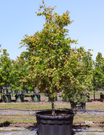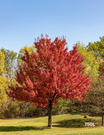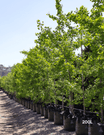Choosing the right trees for your garden can be a delightful experience, especially when you find those that enhance the beauty of your landscape and thrive in less-than-ideal soil. Poor soil conditions can frustrate many garden enthusiasts, but you can create a thriving, resilient garden with the proper selection and a few amendments. This post will explore hardy, beautiful tree options and share tips for amending poor soil to ensure your trees can flourish.
Let’s take a closer look at Betula pendula (Silver Birch), Robinia pseudoacacia 'Frisia', and Eucalyptus camaldulensis (River Red Gum)—three magnificent trees known for their ability to tolerate poor soil conditions. We’ll also provide tips for improving soil to give them the best chance to grow strong and healthy.
Why Trees in Poor Soil Can Thrive with Proper Care
Soils that are sandy, compacted, or nutrient-deficient can be inhospitable to many plant species. However, certain tree varieties have adapted to these challenging conditions. While some trees are naturally resilient, others benefit greatly from simple soil improvements. A few key soil amendments can make all the difference in transforming a lackluster garden into a lush oasis.
Common Poor Soil Types:
- Sandy Soils: These drain too quickly, often lacking essential nutrients.
- Clay Soils Tend to be dense and compacted, leading to poor drainage and limited root growth.
- Shallow Soils: Provide minimal space for roots to expand and find nutrients.
Selecting the right trees and learning how to enrich the soil will ensure your garden survives and thrives. Let’s dive into some tree species and how to care for them in less-than-ideal conditions.
1. Betula pendula (Silver Birch)
Betula pendula, commonly known as Silver Birch, is one of the most elegant trees to grace a garden. Its graceful, drooping branches and striking white bark create a tranquil, ethereal atmosphere. Its delicate appearance belies its hardy nature. Silver Birch trees are highly adaptable and grow well in poor, sandy soils, making them perfect for challenging garden environments.
Benefits of Silver Birch:
- Tolerates Poor Soil: Thrives in low-nutrient, sandy, or stony soils.
- Drought Resistant: Once established, it can tolerate dry conditions.
- Aesthetic Appeal: Its white bark provides stunning year-round visual interest.
Amendments for Betula pendula:
- Mulching: Adding a layer of organic mulch around the tree's base helps retain moisture and provides slow-release nutrients as it breaks down.
- Compost: Work compost into the soil when planting to improve its structure and nutrient content.
- Mycorrhizal Fungi: Incorporating these beneficial fungi encourages root growth and improves the tree’s ability to absorb nutrients from poor soils.
2. Robinia pseudoacacia 'Frisia'
If you're seeking a tree that offers striking contrast and thrives in adverse conditions, the Robinia pseudoacacia 'Frisia' is an excellent choice. Its golden-yellow foliage adds a bright, cheerful splash to any garden, and it’s known for its ability to thrive in poor soils, including dry, compacted, or degraded land.
Why Choose Robinia 'Frisia':
- Fast-growing: This hardy tree establishes quickly, even in tough soil.
- Soil Improver: As a legume, Robinia can fix nitrogen into the soil, subtly enriching it over time.
- Low Maintenance: Tolerant of dry, compact soils and requires little care once established.
Soil Amendments for Robinia:
- Aeration: Aerate the area around the tree to improve compacted soils. This allows roots to breathe and promotes better water absorption.
- Organic Fertilizer: Apply a slow-release, organic fertilizer to ensure a steady supply of nutrients.
- Topsoil Enrichment: If the soil is extremely poor, mixing in loamy topsoil can help improve water retention and nutrient availability.
3. Eucalyptus camaldulensis (River Red Gum)
Native to Australia, the Eucalyptus camaldulensis, or River Red Gum, is renowned for its ability to thrive in poor, dry soils. It is often found near riverbeds or areas prone to drought. This fast-growing tree offers a touch of the wild Australian landscape and is highly resilient, making it a perfect choice for those looking to add a hardy and unique tree to their garden.
Key Features of River Red Gum:
- Drought Tolerant: Ideal for gardens that experience hot, dry conditions or have poor water retention.
- Low Nutrient Requirements: Requires little in the way of soil amendments to thrive, making it a robust choice for difficult conditions.
- Wildlife Attraction: Its flowers and seeds attract various birds and insects, adding biodiversity to your garden.
Soil Care for Eucalyptus:
- Gypsum for Clay Soils: If your soil is clay-heavy, adding gypsum can help break up the soil and improve drainage.
- Deep Watering: This tree's deep roots benefit from occasional deep watering during dry periods, ensuring it receives adequate moisture.
- Minimal Fertilization: Eucalyptus doesn’t require much fertilization, but adding a layer of compost or mulch will support healthy growth.
Tips for Amending Poor Soil to Support Tree Growth
Even though these trees are well-equipped to handle less-than-ideal soil, giving them a strong start will ensure better growth and longevity. Here are some practical tips to improve poor soils:
1. Add Organic Matter
Incorporating organic matter like compost, aged manure, or leaf mold improves soil structure, increases moisture retention, and provides essential nutrients for tree roots to access.
2. Mulching
A thick layer of mulch (such as wood chips or straw) around the base of trees helps conserve moisture, suppress weeds, and slowly releases nutrients as it decomposes.
3. Improve Drainage
For trees planted in heavy, clay soils, creating raised beds or improving drainage can prevent waterlogging, allowing roots to spread and breathe.
4. Consider Soil pH
Some trees may prefer slightly acidic or alkaline soils. Test your soil pH and amend it with lime or sulfur as necessary to suit the preferences of your chosen trees.
5. Aerate Compacted Soil
If your soil is compacted, regularly aerating it can create pathways for air, water, and nutrients to reach deep into the root zone.
FAQs
1. What trees grow best in sandy soil?
Trees like Betula pendula and Eucalyptus camaldulensis thrive in sandy, well-draining soils.
2. Can I plant trees in clay soil?
Trees such as Robinia pseudoacacia 'Frisia' can tolerate clay soils to improve drainage, especially with some soil amendments like gypsum.
3. How do I know if my soil is poor?
Soil is considered poor if it's low in organic matter and nutrients or has poor structure, often leading to water drainage issues or compaction.
By choosing hardy trees like Betula pendula, Robinia pseudoacacia 'Frisia,' and Eucalyptus camaldulensis and following simple soil amendment strategies, you can ensure that even the most challenging soils produce beautiful, thriving trees. Whether your garden suffers from nutrient deficiencies or poor drainage, these trees are resilient and rewarding additions that will elevate the aesthetic and biodiversity of your outdoor space.












































Leave a comment
This site is protected by hCaptcha and the hCaptcha Privacy Policy and Terms of Service apply.